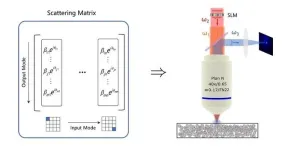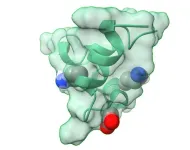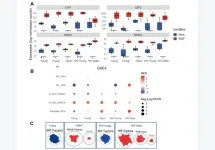(Press-News.org) URBANA, Ill. — Love it or hate it, broccoli is chock-full of health-promoting chemicals linked to heart health, cancer prevention, immune function, weight management, and more. However, some people are less efficient than others at unlocking those chemical benefits. A research team at the University of Illinois Urbana-Champaign suggests gut microbe communities may be responsible for the variation. With a new grant from the USDA’s National Institute of Food and Agriculture, the team plans to identify which microbes maximize the benefits of broccoli and other brassica vegetables.
Gut microbes only factor in when we eat cooked broccoli. When eating the vegetable raw, healthy compounds — and a bitter taste — are unleashed with every gnash of our teeth, the result of a chemical reaction activated by physical damage. Eliminating the bitterness is easy; we just have to cook it. But cooking inactivates the enzyme involved in the reaction, myrosinase. Thankfully, some microbes manufacture their own version of myrosinase, making it possible for them to complete the reaction in the gut with varying levels of efficiency.
“Gut bacteria can metabolize glucosinolates in broccoli to isothiocyanates (ITCs), the bioactive compounds with known health benefits, but they can also break glucosinolates into other inactive materials that do nothing for us. We’re focusing on the flux between these metabolic outcomes and how we can potentially steer that flux towards ITCs and away from the non-bioactive products,” said Michael Miller, principal investigator of the grant and professor in the Department of Food Science and Human Nutrition, part of the College of Agricultural, Consumer and Environmental Sciences (ACES) at U. of I.
The first step is identifying which bacteria are involved and how efficiently they produce ITCs versus non-beneficial compounds. Miller’s team has a study underway in mice, a model system that can provide clues for future human studies. He is feeding the mice broccoli and kale, both cooked and uncooked, to understand the chemical and microbial dynamics of the system.
Once ITCs are unlocked — whether in the mouth or the gut — they trigger bitter-taste receptors in cell membranes, starting a series of reactions that produce hormones affecting glucose homeostasis and the perception of fullness.
“We actually have bitter taste receptors all the way down, not just in our mouths, but in our colon and small intestine, too,” Miller said. “The goal of our work is to show that the bitter compounds (ITCs) made by gut bacteria from metabolizing broccoli trigger bitter taste receptors in the gut and impact satiety, causing mice to eat less.”
Once he identifies bacterial superstars that maximize ITC production for anti-cancer and weight management benefits, Miller says custom probiotics could be developed to help level the playing field for people with lower-efficiency microbial communities. He also predicts his research will inform recommendations about whether raw or cooked broccoli (or kale) might be more useful for weight loss.
END
New grant to optimize gut microbes, boost health benefits of broccoli
2023-08-31
ELSE PRESS RELEASES FROM THIS DATE:
Illuminating new horizons: Navigating nonlinear scattering with precision
2023-08-31
In the intricate world of light, a journey through inhomogeneous media often leads to distortions in space, time, spectrum, and polarization. These distortions, detrimental to applications like optical manipulation, imaging, and communication, have long posed a challenge. Enter the art of wavefront shaping (WS) — a potent tool for correcting these wave maladies in linear optics. But that's not all. Nonlinearity adds a twist, finding purpose in fields from biological sensing to phototherapy. Now, picture combining these forces — ...
Digging deeper into how vaccines work against parasitic disease
2023-08-31
COLUMBUS, Ohio – Scientists have established the effectiveness of vaccines they developed to prevent the disfiguring skin disease leishmaniasis in animal studies, and Phase 1 human trial planning is in motion for the most promising candidate.
But in new work, the research team has determined how these vaccine candidates, created using mutated disease-causing parasites, prompt molecular-level changes in host cells that have specific roles in helping generate the immune response.
Despite using the same CRISPR ...
Housing heroes: New program to support veterans experiencing homelessness
2023-08-31
Since 2009, the number of veterans experiencing homelessness across the United States has shrunk by more than 50%, according to a 2022 Department of Housing report.
With the support of a $150,000 grant from the Department of Veterans Affairs (VA), the University of Missouri School of Law Veterans Clinic is aiming to continue this trend here at home with a new program designed to further empower veterans in taking steps out of homelessness.
The Veterans Outreach Program will help attorneys connect with veterans experiencing homelessness with the goal of offering them the legal assistance ...
Mapping the coronavirus spike protein could provide insight into vaccine development
2023-08-31
Although the COVID-19 pandemic was the first time most of humanity learned of the now infamous disease, the family of coronaviruses was first identified in the mid-1960s. In a new study, molecular biologist Steven Van Doren, a scientist in the University of Missouri College of Agriculture, Food and Natural Resources, has uncovered unexpected actions of a key player in how the coronavirus infects its target — a discovery that could guide further vaccine development.
Funded by a National Science Foundation (NSF) grant, Van Doren and his team studied the fusion peptide, an important feature of the spike protein that serves to bind the virus with ...
Dectin-1 stimulation promotes distinct inflammatory signature in HIV and aging
2023-08-31
“To our knowledge, our study is the first to evaluate the specific function of Dectin-1 in the setting of aging and HIV-infection.”
BUFFALO, NY- August 31, 2023 – A new research paper was published on the cover of Aging (listed by MEDLINE/PubMed as "Aging (Albany NY)" and "Aging-US" by Web of Science) Volume 15, Issue 16, entitled, “Dectin-1 stimulation promotes a distinct inflammatory signature in the setting of HIV-infection and aging.”
Dectin-1 is an innate immune receptor that recognizes and binds β-1, 3/1, 6 glucans on fungi. In this new study, researchers Archit Kumar, Jiawei Wang, Allen Esterly, Chris ...
Excess ceramide and disrupted iron metabolism in neuronal mitochondria found to be the cause for MEPAN syndrome
2023-08-31
A recent study published in Nature Metabolism has revealed the pathogenic mechanism underlying a rare pediatric neurodegenerative disorder known as mitochondrial enoyl reductase protein-associated neurodegeneration (MEPAN) syndrome. The study was led by Dr. Hugo J. Bellen, distinguished service professor at Baylor College of Medicine, and Chair of Neurogenetics at the Jan and Dan Duncan Neurological Research Institute at Texas Children’s Hospital (Duncan NRI), and Dr. Debdeep Dutta, a postdoctoral fellow in the Bellen lab. The Duncan NRI team found that in patients and animal models of this disorder, a large number of neurons ...
A new approach to stop cancer growth?
2023-08-31
CLEVELAND– Case Western Reserve University biochemical researchers have identified a new function of a key protein that leads to cancer–a finding they believe could lead to more effective treatments for a range of cancers and other diseases.
The protein is LSD1 (lysine-specific histone demethylase 1A), which functions as a type of traffic cop inside human cells. It controls gene activity during embryonic development and regulating gene expression throughout life.
Scientists have also identified in recent years that the overexpression of LSD1—in this instance, producing too many proteins—can ...
Study: ‘Suicidal’ mechanism discovered in ion channel receptors enables the sensing of heat and pain
2023-08-31
BUFFALO, N.Y. – The ability to accurately detect heat and pain is critical to human survival, but scientists have struggled to understand on a molecular level exactly how our bodies sense these potential risks.
Now, University at Buffalo researchers have unraveled the complex biological phenomena that drive these critical functions. Their research, published in the Proceedings of the National Academy of Sciences on Aug. 28, has uncovered a previously unknown and completely unexpected “suicidal” reaction in ion channel receptors that explains the complicated mechanisms that underlie sensitivity to temperature and pain.
The ...
Scientists unpick how lung cells induce immune response to influenza
2023-08-31
Researchers from Trinity College Dublin have discovered some new and surprising ways that viral RNA and influenza virus are detected by human lung cells, which has potential implications for treating people affected by such viruses.
Influenza viruses remain a major threat to human health and can cause severe symptoms in young, elderly, and immuno-compromised populations, leading to annual epidemics which endanger between 3 and 5 million people of severe illness and cause 290,000 to 650,000 deaths worldwide.
These viruses primarily target respiratory epithelial cells ...
Expanding the impact of CAR T cell therapy: An immunotherapy strategy against all blood cancers
2023-08-31
PHILADELPHIA – A broad new strategy could hold hope for treating virtually all blood cancers with CAR T cell therapy, which is currently approved for five subtypes of blood cancer. Scientists in the Perelman School of Medicine at the University of Pennsylvania have demonstrated the potential efficacy of this approach in preclinical tests.
In the study, published today in Science Translational Medicine, the researchers used engineered CAR T cells to target CD45—a surface marker found on nearly all blood cells, including nearly all blood cancer cells. Because CD45 is found on healthy blood cells too, the research team used CRISPR base-editing to develop a method ...




